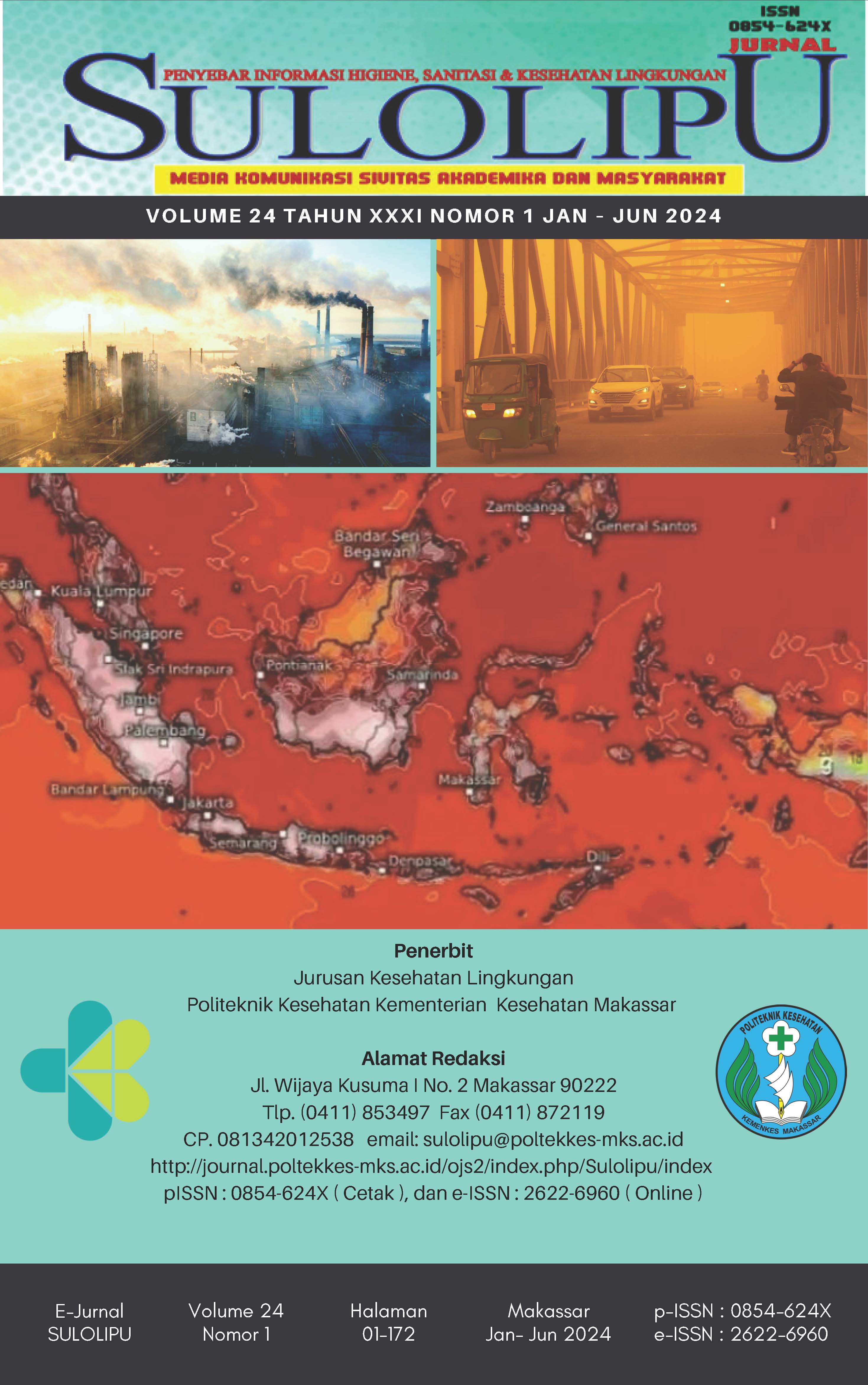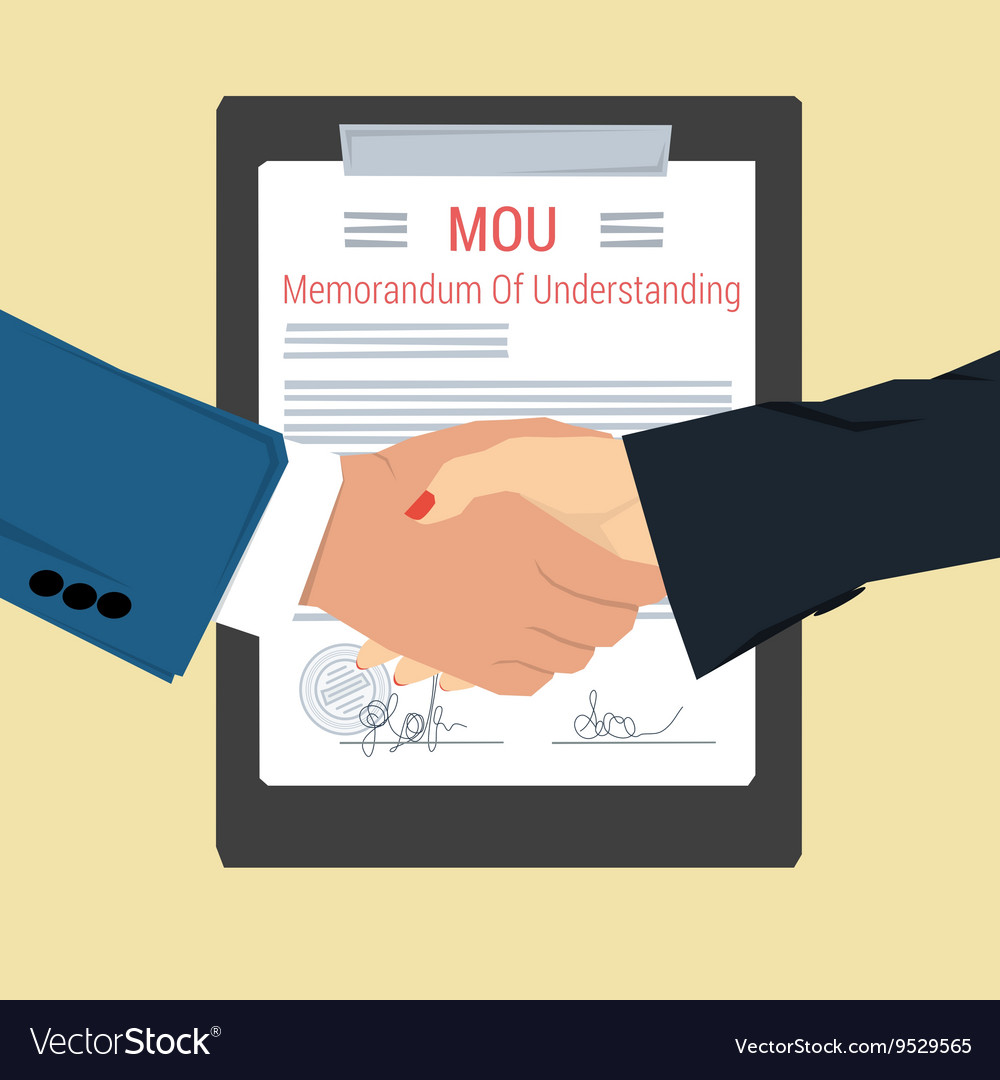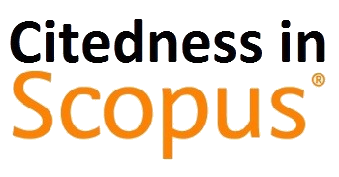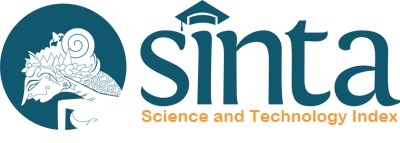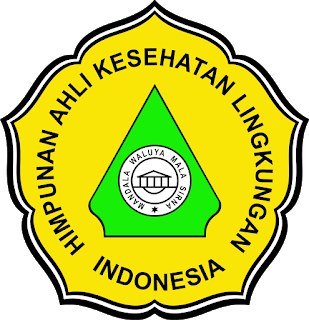The Relationship Of Application Of Community-Based Total Sanitation (STBM) Pillar 2 And 3 With Diarrhea Disease In Lagego Village, Burau District, East Luwu Regency
DOI:
https://doi.org/10.32382/sulo.v24i1.475Keywords:
Sanitasi Total Berbasis Masyarakat, Pilar 2, Pilar 3, DiareAbstract
Diarrhea is having three or more bowel movements a day with the consistency of loose stools which may be accompanied by vomiting or bloody stools.This study aims to determine the relationship between the implementation of Community-Based Total Sanitation (STBM) Pillars 2 and 3 with the incidence of diarrhea in Lagego Village, Burau District, East Luwu Regency. This type of research is analytic observational with a cross-sectional approach, that is going directly to the field using a questionnaire to the causal relationship between the two variables on an observational basis. The Result of this study indicate that 56 respondents have not implemented STBM pillar 2 and 30 respondents have implementes STBM pillar 2. As for the implementation of STBM pillar 3, there are 11 respondents who have not implemented STBM pillar 3 and 47 respondents who have implemented STBM pillar 3. The results of the analysis show that there is a relationship between the application of community-based total sanitation (STBM) pillar 2 with the incidence of diarrhea (p=0.000<0.05) and pillar 3 with the incidence of diarrhea (p=0.001<0.05). This is because the community still considers the behavior of washing hands with soap and the management of household food drinking water not included in things that are very important to do. Marry people especially those in the research locations have not implemented the STBM Pillars 2 and 3, so there are still many people who suffer from diarrhea. So that the community is advised to be able to apply STBM Pillar 2 (washing hands with soap) and Pillar 3 (management of household food drinking water) programs to avoid the occurence of diarrheal diseases.
Keywords : Community Based Total Sanitation, Pillars 3 and 3 STBM, Diarrhar
References
Adebimpe, W. O., Faremi, A. O., dan Hassan, A. W. O. (2018). Prevalence and knowledge of Salmonella infections among food handlers: Implications for school health in Southwestern Nigeria. Sahel Medical Journal, 21(2), 99–103. (online). https://doi.org/10.4103/smj.smj (Diakses pada tanggal 4 Desember 2022)
Ariska, T. M. (2022). Analisis intervensi stbm terhadap kejadian diare di wilayah puskesmas rajabasa indah kota bandar lampung. 16(2), 93–100. (online). https://ejurnal.poltekkes-tkj.ac.id/index.php/JKESLING/article/view/Tike%20Maya%20Ariska (Diakses pada tanggal 2 Desember 2022)
Budiman,dkk. (2013). Hubungan Sanitasi Total Berbasis Masyarakat Dengan Kejadian Diare Pada Balita Di Kelurahan Cibabat Kecamatan Cimahi Barat. 2(1), 189-194. (online). https://proceeding.unisba.ac.id/inde.php/sains_teknologi/article/view/639 (Diakses pada tanggal 7 April 2023)
Darmawan, D. (2019). profil kesehatan Indonesia 2019. In Journal of Chemical Information and Modeling. (online). https://www.kemkes.go.id/downloads/resources/download/pusdatin/profil-kesehatan-indonesia/Profil-Kesehatan-Indonesia-2019.pdf (Diakses pada tanggal 3 Desember 2022)
Direktorat Jenderal Penyehatan Lingkungan, K. K. (2012). Pedoman Pelaksanaan Teknis STBM. Kesehatan, 1–72. (online). http://stbm.kemkes.go.id/public/docs/reference/5b99c4c2576e12f4c9a2019139312658b2f3704c9abc5.pdf (Diakses pada tanggal 2 Desember 2022)
Falasifa, Mila. (2015). Hubungan Antara Sanitasi Total Dengan Kejadian Diare Pada Balita Di Wilayah Kerja Puskesmas Kepil 2 Kecamatan Kepil Kabupaten Wonosobo Tahun 2015. Skripsi. Universitas Negeri Semarang. (online). http://lib.unnes.ac.id/23500/ (Diakses pada tanggal 7 April 2023)
Harahap, N. W., Arto, K. S., Supriatmo, dan Dalimunthe, D. A. (2020). Hubungan Pengetahuan Anak tentang Cuci Tangan dengan Kejadian Diare di Desa Panobasan. Scripta Score Scientific Medical Journal, 2(1), 14–19. (online). https://doi.org/10.32734/scripta.v2i1.3392 (Diakses pada tanggal 5 Desember 2022)
Harsa, I. M. S. (2019). The Relationship Between Clean Water Sources And The Incidence Of Diarrhea In Kampung Baru Resident At Ngagelrejo Wonokromo Surabaya. Journal of Agromedicine and Medical Sciences, 5(3), 124. (online). https://doi.org/10.19184/ams.v5i3.13813 (Diakses pada tanggal 3 Desember 2022)
Hartanti, R.D., Trina, K., dan Reni, M. (2019). Perilaku Hidup Bersih dan Sehat (PHBS) Melalui Budaya Cuci Tangan Pakai Sabun (CTPS). 124-128 (online). http://repository.urecol.org/index.php/proceeding/article/view/843 (Diakses pada tanggal 5 April 2023)
Ikrimah, I., Maharso, M., dan Noraida, N. (2019). Hubungan Pengelolaan Air Minum dan Makanan Rumah Tangga Dengan Kejadian Diare. Jurnal Kesehatan Lingkungan : Jurnal Dan Aplikasi Teknik Kesehatan Lingkungan, 15(2), 655–660. (online). https://doi.org/10.31964/jkl.v15i2.134 (Diakses pada tanggal 5 Desember 2022)
Kemenkes. 2021. Cuci Tangan Pakai Sabun Turunkan Kasus Penyakit Diare dan ISPA. (online). https://kesmas.kemkes.go.id/konten/133/0/cuci-tangan-pakai-sabun-turunkan-kasus-penyakit-diare-dan-ispa (Diakses pada tanggal 6 Desember 2022)
Kemenkes RI. (2021). Profil Kesehatan Indo-nesia. In Pusdatin.Kemenkes.Go.Id. (online). https://www.kemkes.go.id/downloads/resources/download/pusdatin/profil-kesehatan-indonesia/Profil-Kesehatan-2021.pdf (Diakses pada tanggal 4 Desember 2022)
Kursani, E., Beny, Y., dan Fitriani, A. (2017). Hubungan Lingkungan Dengan Kejadian Diare Pada Balita Di Desa Logas Kabupaten Kuantan Singingi. Jurnal Kesehatan Al Irsyad, 10(2), 10 - 19. (online). https://jka.universitasalirsyad.ac.id/inde.php/jka/article/view/77 (Diakses pada tanggal 7 April 2023)
Notoatmodjo, S. (2018). Metode Penelitian Kesehatan, Cetakan Ke Tiga. Pt Rineka. Jakarta. Pamsimas. (2021). Memaknai Budaya Cuci Tangan Pakai Sabun (CTPS). (online). https://pamsimas.pu.go.id/memaknai-budaya-cuci-tangan-pakai-sabun-ctps/ (Diakses pada tanggal 3 Desember 2022)
Parlaungan, J., Loihala, M., Tambunan, S. G., Mensen, R., & Tarmani, R. S. A. (2023). Pendidikan Kesehatan melalui 8 (Delapan) Pesan Perilaku Hidup Bersih dan Sehat (PHBS) pada Guru TK/PAUD. Penerbit NEM. Permenkes RI No.3. (2014). Peraturan Menteri Kesehatan Republik Indonesia Nomor 3 Tahun 2014. (online). http://hukor.kemkes.go.id/uploads/produk_hukum/PMK%20No.%203%20ttg%20Sanitasi%20Total%20Berbasis%20Masyarakat.pdf (Diakses pada tanggal 1 Desember 2022
Pinontoan, Ordi Roni, dan Oksfriani J.S. (2019). Dasar Kesehatan Lingkungan. Yogyakarta : CV Budi Utama Riskesdas. (2018).
Laporan Provinsi Sulawesi Selatan Riskesdas 2018. In Badan Penelitian Dan Pengembangan Kesehatan (Vol. 110, Issue 9). (online). http://ejournal2.litbang.kemkes.go.id/index.php/lpb/article/view/3658 (Diakses pada tanggal 3 Desember 2022)
Saputri, N., dan Astuti, Y. P. (2019). Hubungan Faktor Lingkungan Dengan Kejadian Diare Pada Balita Di Puskesmas Bernung. Jurnal Ilmu Keperawatan Dan Kebidanan, 10(1), 101. (online). https://doi.org/10.26751/jikk.v10i1.619 (Diakses pada tanggal 1 Desember 2022)
Sinaga, E. (2013). Personal Hygiene, Washing Eating Utensils And Amount Of Eating Utensils Bacteria At The Food Sellers Center In Kampung Solor, Kupang. 11(1), 373-438. (online). https://media.neliti.com/media/publications/259643-personal-hygiene-washing-eating-utensils.pdf (Diakses pada tanggal 7 April 2023)
Stiawati, T. (2021). Program Sanitasi Total Berbasis Masyarakat (STBM) untuk Merubah Perilaku Hidup Sehat di Kelurahan Kasunyatan Kota Serang Provinsi Banten. Sawala : Jurnal Administrasi Negara, 9(2), 179–191. (online). https://doi.org/10.30656/sawala.v9i2.3607 (Diakses pada tanggal 4 Desember 2022) Sumampouw, Oksfriani Jufri, dkk. 2017. Diare Balita. (online). https://books.google.co.id/books (Diakses pada tanggal 9 Januari 2023)
Wahyuni. (2020). Hubungan Pengetahuan Dengan Perilaku Kebiasaan Cuci Tangan Pakai Sabun Pada Masyarakat Kelurahan Lompo Riaja. Skripsi. Universitas Muhammadiyah Makassar. (online). https://digilibadmin.unismuh.ac.id/upload/22325-Full_Text.pdf (Diakses pada tanggal 6 Desember 2022)
WHO. (2017). Diarrhoeal Disease. (online). https://www.who.int/news-room/fact-sheets/detail/diarrhoeal-disease (Diakses pada tanggal 3 Desember 2022)
Widiastuti, F. (2012). Hubungan Higiene Sanitasi Makanan Dan Minuman Dengan Kejadian Diare Pada Balita Di Wilayah Kerja Puskesmas Gatak Kabupaten Sukoharjo. https://eprints.undip.ac.id/38798/ (Diakses pada tanggal 7 April 2023)
Downloads
Published
How to Cite
Issue
Section
PDF (Bahasa Indonesia) downloaded: 541

